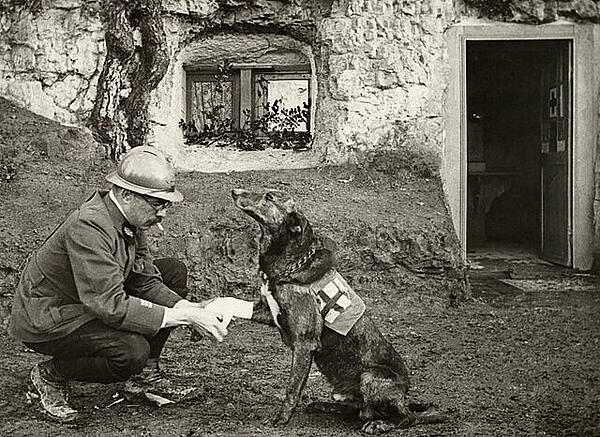Dogs in World War One
While trench warfare made it difficult for the military to rely as heavily on cavalry as it previously had, the complexities of this method of battle made dogs even more crucial than they had been previously.
Figures suggest that, by the end of World War One in 1918, Germany had employed an estimated 30,000 dogs, while Britain, Belgium and France had used 20,000 and Italy had used 3,000. The United States did not initially use dogs during the war, but a chance stowaway resulted in America producing the most decorated and highly-ranked service dog in military history - Sergeant Stubby.
Many different breeds of dogs were utilised during World War One, with the most common being the medium-sized easily trainable breeds. For Germany, this meant utilising a huge number of German Shepherd Dogs and Doberman Pinchers, both of which are strong, agile and trainable. Both also display high levels of intelligence and excellent guarding abilities.
Smaller breeds were also employed during the war, including terriers. These were often used as ‘ratter’s, and would be placed in trenches to prevent the spread of disease.

There were many roles and functions for dogs in the military during World War One, with breeds of different sizes and abilities being given different positions in the war effort. The common roles included:
Sentry Dogs
Sentry dogs were trained to work with one specific guard, and would join them in a patrol on a short lead. These dogs were often trained to deliver a warning signal such as a grow or bark when they believed an unknown or unwelcome person was present in a specified area. Dobermans were commonly placed in this role.
Scout Dogs
Scout dogs were highly trained and often very calm in nature. Their role was to work with foot soldiers as they quietly scouted the terrain ahead. Unlike humans, these dogs were able to detect an enemy up to 1,000 yards away, and would alert silently via the pointing of its tail to avoid alerting the enemy.
Casualty Dogs
Also known as ‘mercy’ dogs (or ‘sanitathunde’ in Germany), casualty dogs were used across Europe during World War One and were specifically trained to detect wounded and dying soldiers on the battlefield. These dogs were trained to work with medical equipment strapped to them, which would make it easy for the soldiers to access the supplies they needed to get to safety or wait for help. The mercy dogs would also sit with dying soldiers in their last moments, providing comfort.
Messenger Dogs
Dogs were frequently used as messengers during the war, proving to be as reliable as soldiers. Trench warfare meant communication was often difficult and it was quite possible that messages could go missing on their way to headquarters or back to the trenches. This was particularly common when human messengers were used as they made very easy targets for enemies, particularly on the front line. Dogs made a very effectively alternative, being easier to train, smaller and able to travel across any terrain. Britain quickly established a dog training school in Scotland, which would prepare them for working in battle. One dog from the school was so good at his job that he managed to travel more than 4,000 miles over very difficult terrain in less than 60 minutes, delivering a message that had failed to reach headquarters via any other method.
Mascot Dogs
While most dogs were playing more active roles, mascot dogs were specifically trained to provide psychological comfort for the men trapped in the trenches. Even Adolf Hitler is thought to have kept a trench dog during the first world war, and for him and many other people suffering through trench warfare it provided a momentary release from the horrors of war.
MLA Citation/Reference
"Dogs in World War One". HistoryLearning.com. 2026. Web.
